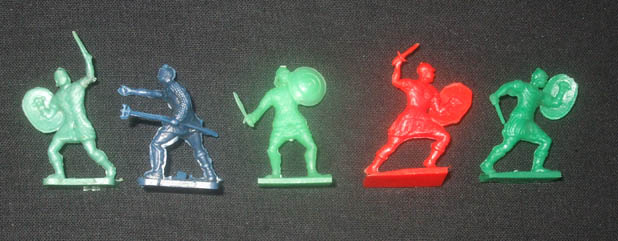

These are some of the many figures that date back to the early days of the hobby but have an uncertain ancestry. These gladiators were never sold as a set but rather were used as free gifts, being advertised as 'Eight different scale models' (apparently the horse did not count).
These figures first saw the light of day as free gifts inside special packs of Sugar Puffs, a cereal made by the Quaker Oats Company. The promotion seems to date from 1964, with the standard-sized box contained two of the foot figures, while the family-sized box contained two foot figures plus one mounted. A copy of the advertisement can be seen on Flickr. Later (in the early 1970s) they were to reappear as small gifts inside Tom Smith crackers, with each holding either two foot figures or one mounted. It seems the mounted figures also appeared in the Baravelli range at much the same time, where they were labelled as Roman Cavalry.
The exact manufacturer of these figures is not known for sure, but it is likely that Quaker would have commissioned them from an established figure maker. Romans had been a popular subject for Hollywood films for much of the 1950s and beyond, with such films as Quo Vadis (1951), Ben-Hur (1959), Cleopatra (1963) and The Fall of the Roman Empire (1964). When gladiators are mentioned of course it is Stanley Kubrick's masterpiece Spartacus (1960) that comes to mind, so many children of the 1960s would have been familiar with such men. Of course, fun though they are, watching classic sword-and-sandal epics will teach you little about the real Roman world, and these figures are no more educationally useful. They are 'Romanesque' in flavour, although many seem to have so little to do with gladiatorial games as to be closer to Roman legionnaires, or at least auxiliaries. Of the figures the blue man with the trident and mailed arm has more of the gladiator about him than most, but historical accuracy was probably never a priority when these were made, and at the time few outside of academic circles would have known what was accurate and what was not, and fewer still would have cared.
The poses are pretty flat but as a stimulus for a child’s imagination they are plenty good enough. Detail is quite vague but it is hard to imagine many children taking the time to paint these or examine them too closely. The mounted gladiators are of course particularly limited if trying to recreate the historical games, while the hollow horse really has nothing much going for it at all. There is a good deal of flash, and certainly by today’s standards these would be considered quite crude.
All this is of course grossly unfair for a product that was never more than a toy, yet for the rather more sophisticated adult collector of today all is not lost. Some of the figures, suitably tidied up (and certainly remounted), could pass for acceptable late Empire Roman soldiers or perhaps Romano-British warriors. It is something of a push, and naturally these figures are hard to track down these days, but the possibilities are there, and at about 24mm in height they fit well with Airfix and other Romans. For many however seeing these colourful characters for the first time in several decades will bring back happy memories of searching cereal packets for that exciting new toy.
Plastic Soldier Review would like to express their thanks to Hugh Walter for his invaluable help in preparing this article, and also to Matt Boult for his assistance. Visit Hugh's Small Scale World blog.